Vacuum-lifting attachments make construction equipment more productive.
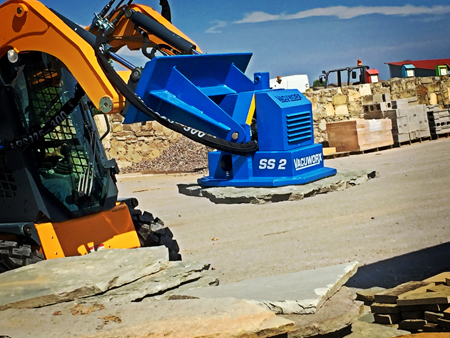 Construction equipment has long been used to move material like large pipes and concrete slabs, typically with ropes, chains or slings tied to the bucket or stick. Lately, however, operators of these machines are turning to vacuum-lifting technology as a faster and safer alternative. According to officials at Vacuworx, Tulsa, Okla., vacuum-based devices can improve worksite productivity and, more importantly, keep workers out of harm’s way.
Construction equipment has long been used to move material like large pipes and concrete slabs, typically with ropes, chains or slings tied to the bucket or stick. Lately, however, operators of these machines are turning to vacuum-lifting technology as a faster and safer alternative. According to officials at Vacuworx, Tulsa, Okla., vacuum-based devices can improve worksite productivity and, more importantly, keep workers out of harm’s way.
Benefits of vacuum
Vacuum-lifting systems work much like simple pick-and-place vacuum cups seen in industrial packaging settings, but on a much larger scale. And they offer numerous benefits over conventional handling operations, explained Bill Solomon, president of Vacuworx. First, vacuum eliminates the need for unsafe and time-consuming lifting mechanisms such as hooks, slings or chains. With no cables and chains to hook and unhook, there is less downtime between lifts and faster load and unload cycles.
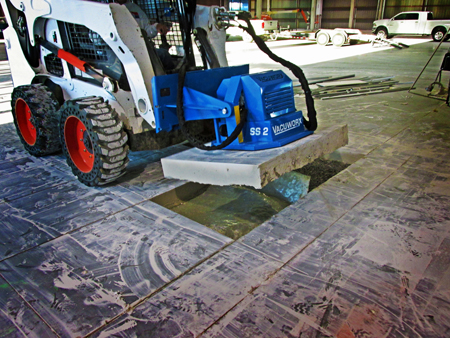
The SS 2 unit brings vacuum-lifting capabilities to skid-steer loaders. It runs off the host machine’s auxiliary hydraulic system with a minimum 10 gpm flow and maximum pressure of 3,000 psi. The all-aluminum product weighs 98 lb and, thanks to quick-connect couplers, readily attaches to any skid steer. The SS 2 handles steel plate, saw-cut concrete, granite and marble slabs, landscape pavers and other materials weighing up to 2,716 lb. Image courtesy of Vacuworx
Second, vacuum ensures a powerful positive engagement of the load, where slings and chains can shift or loosen, endangering employees. And it reduces or eliminates the need for tag-line operators on the ground to hold and guide the load.
Consider the overall economics, said Solomon. A length of chain is obviously less expensive than a sophisticated vacuum handler, but in terms of dollars and cents, it becomes a speed and safety issue, he noted.
“If you’re using chains, imagine you have a machine carrying a 20,000-lb load, and a guy with a tag line on each end trying to guide it and keep it from spinning or wobbling. And the operator of the machine has to watch out for the workers while trying to move and place the load,” he said. Operators can only move the load as fast as the people on the ground, and everything stops if they’re in the way, he continued. “Worse, if the chain breaks and that piece of 20,000 pound material starts to go, the guys holding onto the tag lines are along for the ride.”
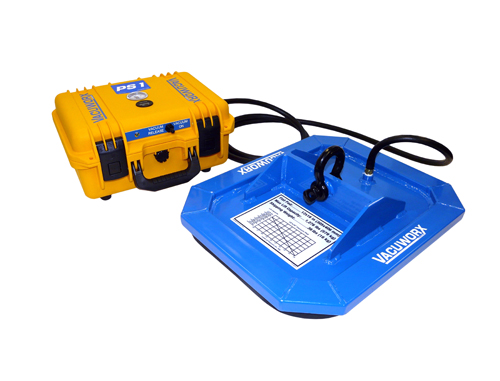
The PS 1 portable vacuum lifting system, powered by rechargeable batteries, has an 8-hr run time. The unit weighs only 25 lb with pads measuring 8 x 12 in. to 16 x 16 in., and can lift up to 1,654 lb. It’s suited for use on small equipment like mini electric excavators. Image courtesy of Vacuworx
Vacuum lifting essentially removes personnel from the work zone. “Now, the operator has full control, not only of lifting, but of placing and manipulating the product. He puts that material where it needs to be and goes back for the next piece in less than a minute,” said Solomon. Conventional processes can take upwards of 15 minutes per cycle, he added.
Also, there is no need for employees to climb on trailers or into trenches to attach and detach the connections, and it also eliminates the need for costly cribbing or spacers for pipe or plate. That plays into the economics and safety of the application as well. Vacuum-lifting systems can increase productivity, while the need for fewer ground personnel reduces the risk of accidents and lowers payroll and insurance costs. ROI is often in 4 to 6 months or less, said Solomon.
How hydraulic vacuum lifting works
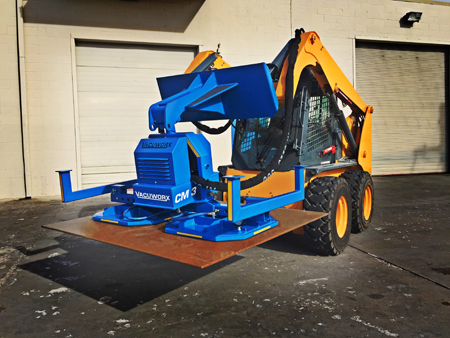
The CM 3 compact modular product adapts to many applications and host machines. With a rugged all-steel construction, the device can accommodate single or double pad configurations and holds a variety of materials like concrete slabs, steel plates and pipe weighing up to 6,600 lb. | courtesy of Vacuworx
Vacuworx systems are comprised of four principal components: a vacuum pump, reservoir, sealing pad, and alarms. Hydraulics on the host machine drives the vacuum pump to operate the system. (Optional versions run off electric motors; and a self-contained unit has an 8-hp diesel engine as the motive force.)
In a standard system, the machine’s auxiliary hydraulics powers a hydraulic motor. The motor, in turn, connects through a gearbox to drive a vacuum pump. The pump maintains a near-constant vacuum in the pressure reservoir, which is sized based on application requirements. A suitably sized vacuum reservoir also maintains holding power in the event of a hose break or power failure.
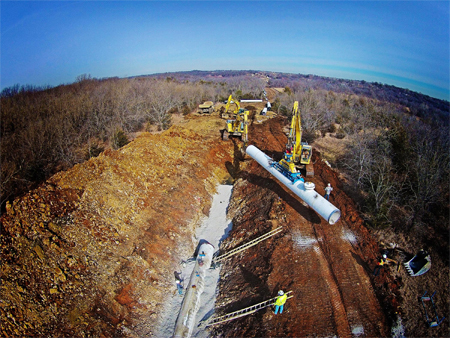
Heavy-duty RC lifters are designed to handle material like large pipe and, as shown below, large concrete sections. Image courtesy of Vacuworx
In a typical medium-size set-up, hydraulic flow is about 10 gpm with a maximum pressure of 3,000 psi. Vacuum level is around 20 to 22 in.-Hg, depending on the lifter and load. When activated, the system pulls a vacuum between one or more pads and the object to be moved, providing a powerful suction and a positive seal—and the needed lifting force. The vacuum seal holds with minimal leakage until the operator activates the release.
Vacuum pads are sized to handle pipe, flat material or special shapes. The pad seal itself is built up from multiple standard elastomeric sections, which Vacuworx calls Tough Seal. The material is formulated to withstand rugged jobsite conditions like abrasion, exposure to oil and water, sunlight and UV radiation. It’s also suited for extreme temperatures, from –40° to 215°F. Rips and tears can be field repaired and worn seals are readily replaceable.
Vacuworx vacuum lifters can adapt to a variety of jobs just by switching out the pad. Standard curved pads fit pipe dimensions from 4 to 48 in. and can be customized for other sizes. Flat pads can be configured to specific dimensions depending on the application. Specialty pads are also available.
Finally, warning lights and audible alarms alert the operator to low vacuum levels or system faults. The system operates via an electronic wireless remote control transmitter with matched receiver. Multiple lifters can work side-by-side without interference.
Varied applications
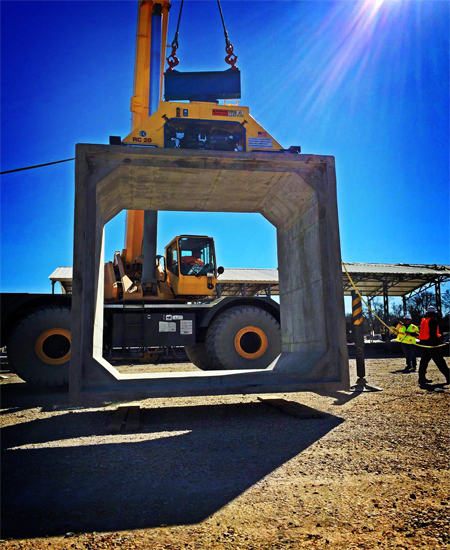 Standard models lift a variety of materials. These include concrete and ductile iron pipe; steel pipe, including products wrapped in tape or with coatings like FBE (fusion-bonded epoxy) and coal-tar enamel; and plastic pipe such PVC and fiberglass. Other materials suitable for vacuum handling are concrete road barriers, saw-cut concrete, sidewalk sections, landscape pavers, pre-cast concrete slabs and culverts, and steel plate and piling. Lifting systems can also be customized for many applications and lift capacities.
Standard models lift a variety of materials. These include concrete and ductile iron pipe; steel pipe, including products wrapped in tape or with coatings like FBE (fusion-bonded epoxy) and coal-tar enamel; and plastic pipe such PVC and fiberglass. Other materials suitable for vacuum handling are concrete road barriers, saw-cut concrete, sidewalk sections, landscape pavers, pre-cast concrete slabs and culverts, and steel plate and piling. Lifting systems can also be customized for many applications and lift capacities.
Lifters can attach to hydraulic excavators and backhoes (with or without coupler systems), wheel or track-type loaders, cranes, pipe layers, skid steers, forklifts and knuckle booms. They can also be mounted for a variety of in-plant applications.
A couple trends are helping shape demand. One is for more-compact and lighter lifters. That’s because less weight hanging off the end of the host machines equates to a greater load capacity, noted Solomon. Another is the number of recently introduced products designed for small machines such as skid steers, loader backhoes, and boom trucks with cranes, he said.
Today’s vacuum-lifting products span a wide range of sizes and lift capabilities. For instance, portable lifting systems powered by rechargeable batteries weigh only about 25 lb but can lift nearly a ton. At the other end of the spectrum, Vacuworx RC Series lifters handle materials weighing up to 55,000 lb. The self-contained units can be powered by diesel engines, or the models can operate off the machine hydraulics and eliminate fuel costs, emissions and noise.
They’ve been used to move pipe sections 42 in. in diameter and 80 ft long, and are capable of gripping pipe up to 120 in. in diameter. The limiting factor is usually the capacity of the host machine.
Versatile lifters
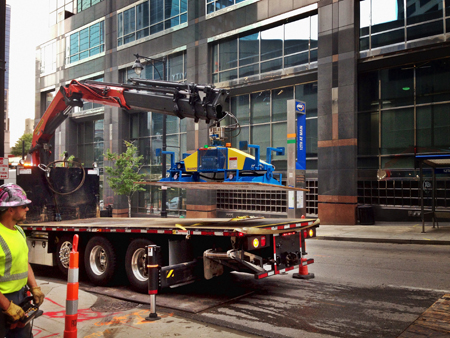
Image courtesy of Vacuworx
The AMC Series hydraulically powered, vacuum-lifting system mounts on machines ranging from compact equipment to larger excavators and truck-mounted articulating cranes. The models have a compact overall footprint and are particularly suited for contractors and rental companies who often must work in congested urban streets and tight spaces. They operate using the hydraulic power from the host machine without significantly reducing the equipment’s overall lifting capacity.
The AMC 6 has a 13,200-lb lift capacity and comes standard with a pin adapter for excavator mounting. The AMC 4 features a hydraulic quick-change adapter for truck-crane applications and has a lift capacity of 8,800 lb. Both models can accommodate single or double vacuum-pad arrangements, and they can grip steel, plastic and concrete pipe, as well as trench plate and
concrete slabs.
Vacuworx
vacuworx.com
Filed Under: Pneumatic Tips, Slider